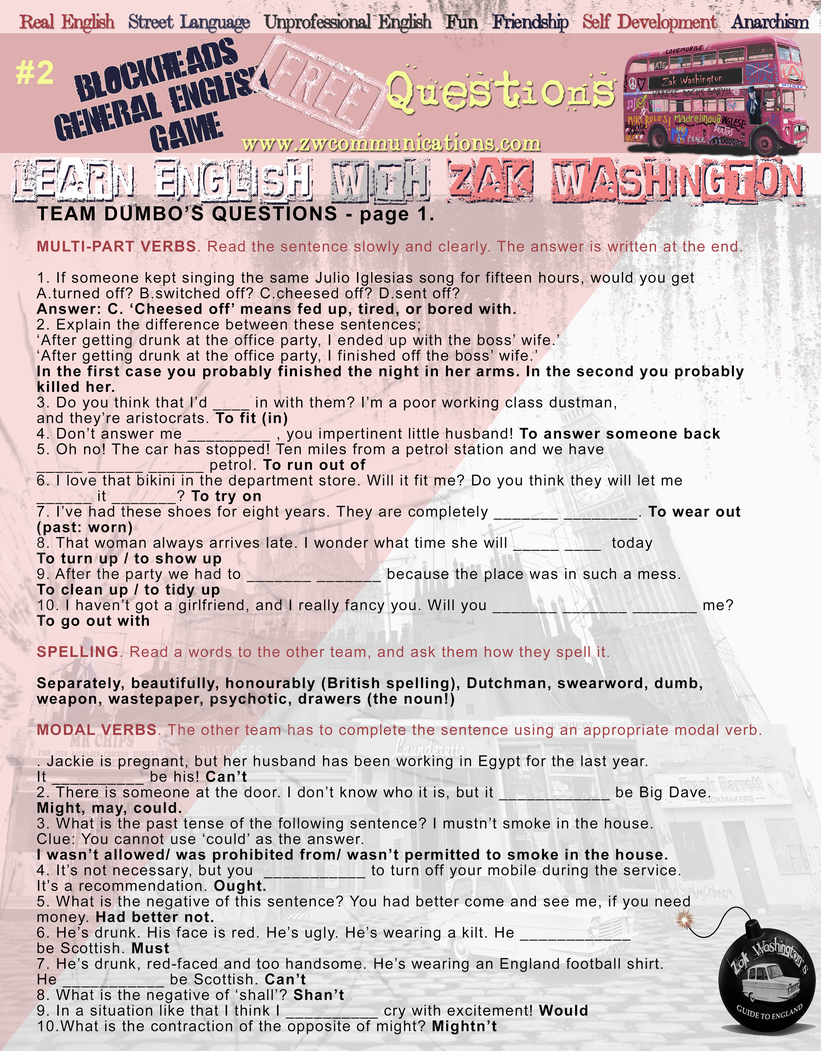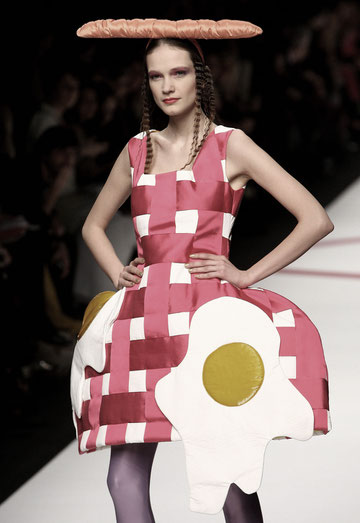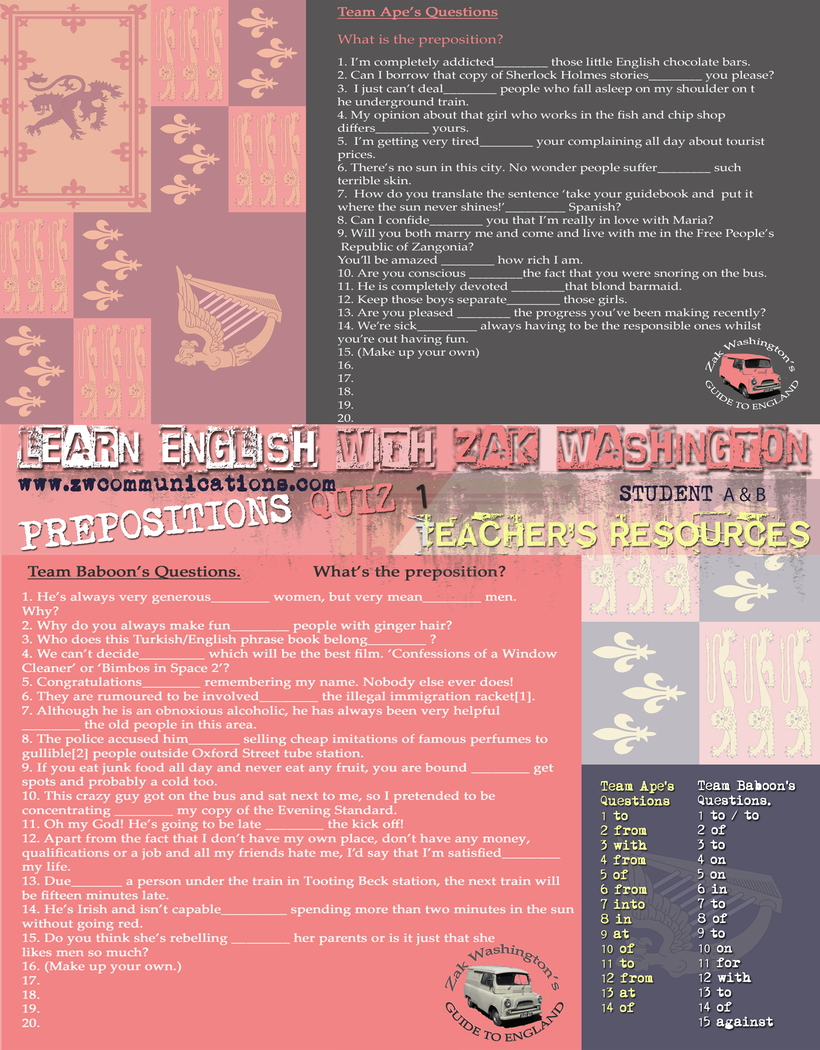

Here are some EFL TEFL ELT ESOL TESOL materials for teachers. These can be used in the classroom, as part of the Zak Washington course, or independently.
Classroom game for EFL TEFL ELT ESOL TESOL students of English
BLOCKHEADS (General English Vocabulary game)
HOW TO PLAY
This is variation of Blockbusters (a 1980s British TV game). Divide students into two groups. One group starts from the horizontal side, answers questions and colours in the blocks. The other team does the same vertically.
When one block is coloured, students have to answer a question from one of the adjoining blocks to eventually form a snake-like line from one side of the board to the other.
The idea is to block the other team and force them to take a longer route.
If the game is too short play best-of-three.
ALTERNATIVELY, play 'fill in all the blocks' - students answer ALL questions in turns. The winner is the group with most coloured in blocks.
Enjoy and please share.

Find the full instructions and the questions in CHAPTER ONE.




Classroom game for EFL TEFL ELT ESOL TESOL students of English
GAME: MY CLASSMATE IS A BIMBO

Get into pairs. Write the name of an occupation. Then use adjectives to describe the qualities necessary to be able to do that job. The other students have to guess what your job is. Don’t make it too obvious. For example.
‘We are strong, persevering, and have much stamina. Most of us do it for pleasure, but some of us are professionals on the circuit. They prefer it if we don’t talk much. We make grunting noises. We have to have good technique. Men look at our underwear. What are we?’
‘That’s easy. Prostitutes!’
‘No try again.’
‘Tennis players?’
‘Correct.’
The same game can be played using famous people or members of the class.
Classroom game for EFL TEFL ELT ESOL TESOL students of English
DEPENDENT PREPOSITIONS BOARD GAME 1
RULES: Play this game with two teams as Three-in-a-Row, Four-in-a-Row (Connect 4, Tris, etc.)
Alternatively, you can play 'fill all the squares'. Use colour pens. Students take turns and colour in one square per correct answer. The winner is the group with most coloured squares.

Classroom game for EFL TEFL ELT ESOL TESOL students of English
DEPENDENT PREPOSITIONS BOARD GAME 2
RULES: Play this game with two teams as Three-in-a-Row, Four-in-a-Row (Connect 4, Tris, etc.)
Alternatively, you can play 'fill all the squares'. Use colour pens. Students take turns and colour in one square per correct answer. The winner is the group with most coloured squares.

Classroom game for EFL TEFL ELT ESOL TESOL students of English
THE DEFINITIONS GAME.
Split yourselves up into two teams. Larger groups can divide themselves into four groups and play two separate game. You are going to imagine that you are in the ‘bric-a-brac’ section of a jumble sale. What is bric-a-brac? The answer is, just about anything that you can find in the house that is small and isn’t clothes, furniture, shoes etc. Bric-a-brac means odd bits and pieces. Sometimes they are indescribable. Your job is to describe the items to the other team. They will have to try and guess the names of the objects that you find. Follow the instructions.
1. Team Cucumber. Use the definitions card below. Team Turnip. Turn to the page after next, and use the card that you find.
2. Do not look at the definitions card of the other team. This will ruin the game! You can only look at the questions that you will ask the other team.
3. Ask the other team the answers.
4. Three points will be awarded for correctly guessing the answer to the question. If you can’t remember what the name is, but know what is being talked about, you can act out the action and receive one point. Answering three correct questions in a row will be awarded with a jackpot[1] prize of five additional points.
[1] Jackpot (noun) sometimes this means a special bonus prize, at other times it refers to just one enormous prize. If you win the lottery, you should phone your friends and tell them that you have hit the jackpot.
Team Cucumber Definitions Card. You will ask the other team these questions.
|
It is a circular object, carried in the waistcoat pocket on a chain. It needs to be wound up. It has gone out of fashion, although it was very popular with gentlemen. A practical fashion accessory. Answer: Pocket watch. |
This is an object that contains a needle, that always points in the same direction, and is very useful when you need to get your bearings. Good for explorers and adventurers. Compass |
|
An electrical mod-con (a household electrical appliance) that you find in almost every British kitchen. It is used for boiling water. You will need one of these if you want to make a nice cup of hot tea. Kettle. |
A long thin tube that contains mercury, and is put into the mouth under the tongue in order to take the temperature of a person who is ill. It’s made of glass. Thermometer. |
|
This is something that goes off in the morning. It might also go off at any other time of the day, if you decide to set it at a different time, for example, after a little afternoon nap (or siesta). Alarm clock. |
This is made of wood and metal, and is attached to the wall with metal brackets. You can put anything on it, although the most common thing would be to fill it with books. Libraries are full of them. Shelf/Shelves. |
|
A metal object that is always spoken about in the plural. It has two blades, and two holes to put your fingers through in order to use it. Barbers love them. Be careful! They’re sharp! Keep out of reach of children. Scissors. |
This item is very thin and quite long. It has an eye at one end, and a sharp point at the other. It is made of metal, and you can use it to sew. To use it correctly, just put a cotton thread through it. Needle. |
|
If you wanted to join pieces of paper together, you might consider using this object. It is made of metal with a rubber base, and can be bought in any good stationers. It is found on most office desks. Stapler. |
Every student in the class has one. We hope that you’ve used yours this morning before coming out. Wouldn’t want you to have smelly breath, would we? It has lots of bristles, and is made of plastic. Toothbrush. |
|
The do-it-yourself enthusiasts of the class will definitely have one of these. For house or mechanical repairs it is essential. Take the handle in your hand and rotate it, to put in or take out screws. Screwdriver. |
Those household cans can be difficult to open! Why not buy yourself one of these useful devices? Just take the tin, pierce the top, and twist around the edge of the can until its open. It’s that easy! Tin-opener/Can-opener. |
|
You’ll find these in the pocket of a lot of men’s jeans, women’s handbags, and on the bathroom shelf. Take this metal or plastic object out, and run it through your hair. There! You’re beautiful again! Comb. |
Girls love to put this stuff on. They won’t be too happy, if they find it on their boyfriend’s shirt collar though! It comes in all different shades, and must be applied to the lips. Lipstick. |
|
A common household item, that’s difficult to pronounce. It has a silent ‘r’. Use it on clothes to flatten them, to steam them, or to take the creases out of them. Careful! Don’t burn your fingers! Iron. |
It’s usually long and thin, and is most common in the colour white. It often comes in a ball. Tie things up with it. Wrap it round a parcel. Cut lengths of it off. Can also be bought in the stationer’s. String. |
|
It’s round, hollow and inflatable. Kick, throw, pass or shoot it. It’s made of leather or sometimes plastic. Some people think it’s a matter of life or death, but it’s much more important than that. Football. |
It’s like a cup, but it’s a bit bigger. A cup is smaller and more delicate and comes with a saucer. This doesn’t. It has a handle. You drink your tea from it. Found in all kitchens and cafés. Mug. |
Team Turnip Definitions Card. You will read these definitions to the other team.
|
When it’s dark and you are out camping, or looking for something in the back garden, you’ll find this thing very useful. Pop some batteries in the back. Turn it on. A beam of light. Great! Now we can see again. Torch. |
This is something that you’ll need if you want to put some nails into the wall. Very useful for household renovations. It has a long wooden handle and a thick metal head. Don’t hit you thumb with it! Ouch! Hammer. |
|
Sometimes those lids are hard to get off. What you need is this metal instrument to make the job easier. Take hold of the wooden handle, twist it, and there you are! Ready to drink! Bottle opener. |
An electrical mod-con that you use in the kitchen. It has a timer, contains springs and has a heating element. Once it it’s ready, it will pop up. You should have a plate and the butter ready. Toaster. |
|
This thing is soft and full of feathers; you will find a few of them in most living rooms. Putting it behind your back will make watching the television much more comfortable. Relax and enjoy! Where’s my pipe? Cushion. |
This is a type of book that contains pages that you can put things into. They are covered with plastic. When you finish your holiday fill it up, and enjoy the memories that looking at the snaps will bring. Album. |
|
It is either sharp or blunt. This object has a handle and a blade, and is used for chopping or carving food. Be careful with the pronunciation! You can’t pronounce all those letters. Knife. |
This useful object is always plural. The frames come in all different shapes and sizes and are very expensive when you consider that they are so small. You’ll need the correct lenses too. Glasses./ Spectacles. |
|
When you are next cooking, you could use one of these. It has a flat base and a rim around the edge. There is a lid to go on top too. This won’t always be necessary. Only touch the handle or you’ll get burnt. Saucepan. |
No bathroom is complete without one of these wonderful objects. Lock yourself in there, and spend hours gazing at your reflection in it. You’ll find one in the hall and the bedrooms too. Mirror. |
|
This is a small piece of stationery that is used to get rid of writing or drawings that have been done in pencil. It has a different name in American English. The name is the same as the substance. Eraser. /Rubber. |
This is a flat piece of metal or plastic that would be used by a waiter or waitress to carry things on. You might put your plates on this, if you decide to eat your dinner in front of the television while sat on the sofa. Tray. |
|
It’s large, it’s usually white in colour, and you find it on a bed. You need to be careful how you pronounce it or you’ll end up saying a swearword. Wear it over your head if you want to look like a ghost! Sheet. |
This is necessary for the process that occurs after you cut food up. You use this object to pick things up from the plate before you put them into your mouth. It is made of stainless steel, and is held in the left hand. Dinner’s ready! Fork. |
|
This is the perfect item for getting rid of that beard! Men can use it on their faces in the morning. But gentlemen, don’t leave it at the side of the bath, or your wives will use it to shave their armpits! Urghh! Razor. |
It’s been a hard day at work. Take those uncomfortable shoes off, and put a pair of these nice, soft, comfy things on instead. Ah!! That’s better! Now where is that newspaper of mine? Slippers. |
|
It is the shape of a cube. It has numbers on each side and should be rolled. Gamblers love them. Absolutely essential for board games, and for playing craps in the local casino. Shake, rattle….. and roll! Good luck! Die./ Dice. |
Put your clothes, and your coats on this thing, then take it and hang it up in the wardrobe. This will help to retain its shape much longer. You won’t need to iron them either. Can be made of metal or plastic. Coat hanger. |
Classroom game for EFL TEFL ELT ESOL TESOL students of English
DEDICATED FOLLOWERS OF FASHION. THE GAME.

Divide yourselves into groups of two or three. Very small groups can play individually. You will need as many dictionaries as possible for this game. You will also need one piece of blank paper per team, some pencils and an eraser [1]. You are going to describe an imaginary person from some period in the last fifty years. You will first get together and discuss with your team exactly what your man or woman is wearing. Take notes. Colours are not important, but attention to detail in describing the person’s clothes, shoes, accessories, and hair is essential. Think about the different materials and the different patterns. When you have finished, take it in turns to dictate descriptions of this person’s appearance to the other teams. The other teams will draw one picture per team, discussing any misunderstandings or differences of opinion, until they finally agree. When all the drawings are finished, the team who dictated the drawing will judge which is the closest drawing to the image that they you had originally thought of. Ten points for the winning picture, and five points for the runner up. It will help to visualise a famous person, and what they typically wore during that period.
Here is an example. This is a tall gentlemen with grease in his dark, straight hair. His hair is combed into a quiff on top, and is cut short on the back and sides. He is wearing a short, long sleeved, black leather jacket, with various pockets, that has a medium-sized collar. Underneath, he is wearing a white T-shirt. He is also wearing tight, black leather trousers, which are held up by a leather belt and large, square, silver buckle. On his feet are a pair of blue suede platform shoes. Wrapped around his face is a pair of black sunglasses, and there are several large rings on his fingers. Students draw the pictures. Let’s have a look at the results... The winner is…..[2]
[1] Eraser (noun) ($) this is an object for rubbing out, or removing pencil marks from a page. The more common noun in British English is a rubber, but this is also the ‘nickname’ for a type of contraception -the condom- in the USA. Americans tend to understand less the differences in vocabulary from the other side of the Atlantic, whereas Britain is saturated with American television and films, and most Brits have a sound knowledge of American vocab. It will be better to get a little embarrassed reading, this that making a big mistake when you go to study in the states.
[2] The winner is …..the team whose picture most closely resembles Elvis Presley, the King of Rock’n’roll in his Comeback Special, that was televised in 1968.
Classroom game for EFL TEFL ELT ESOL TESOL students of English
DEPENDENT PREPOSITIONS QUIZ
HOW TO PLAY:
Divide students into two groups. Each group takes it in turn to ask the other questions.
You can play without a board or teacher can draw a tic-tac-toe (noughts and crosses) on the board, etc.

